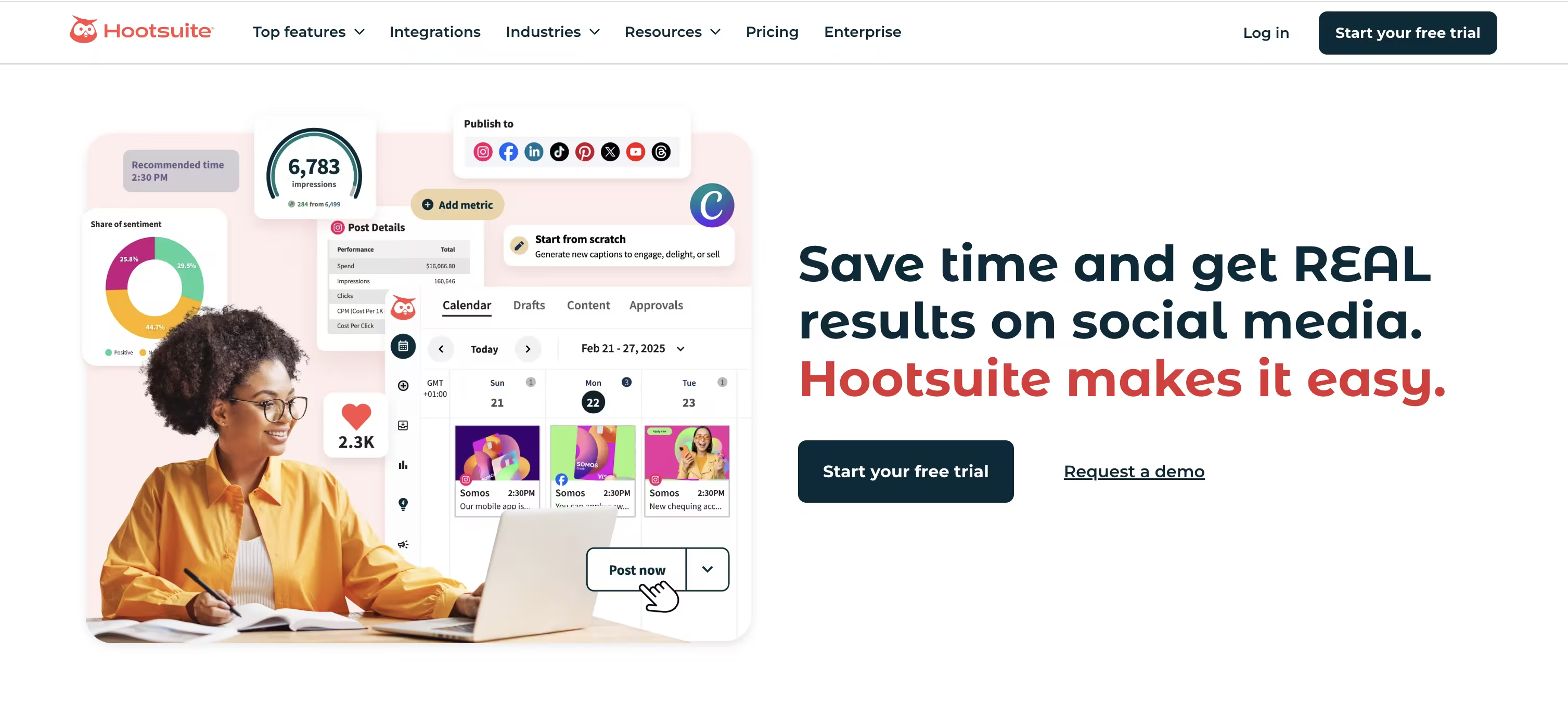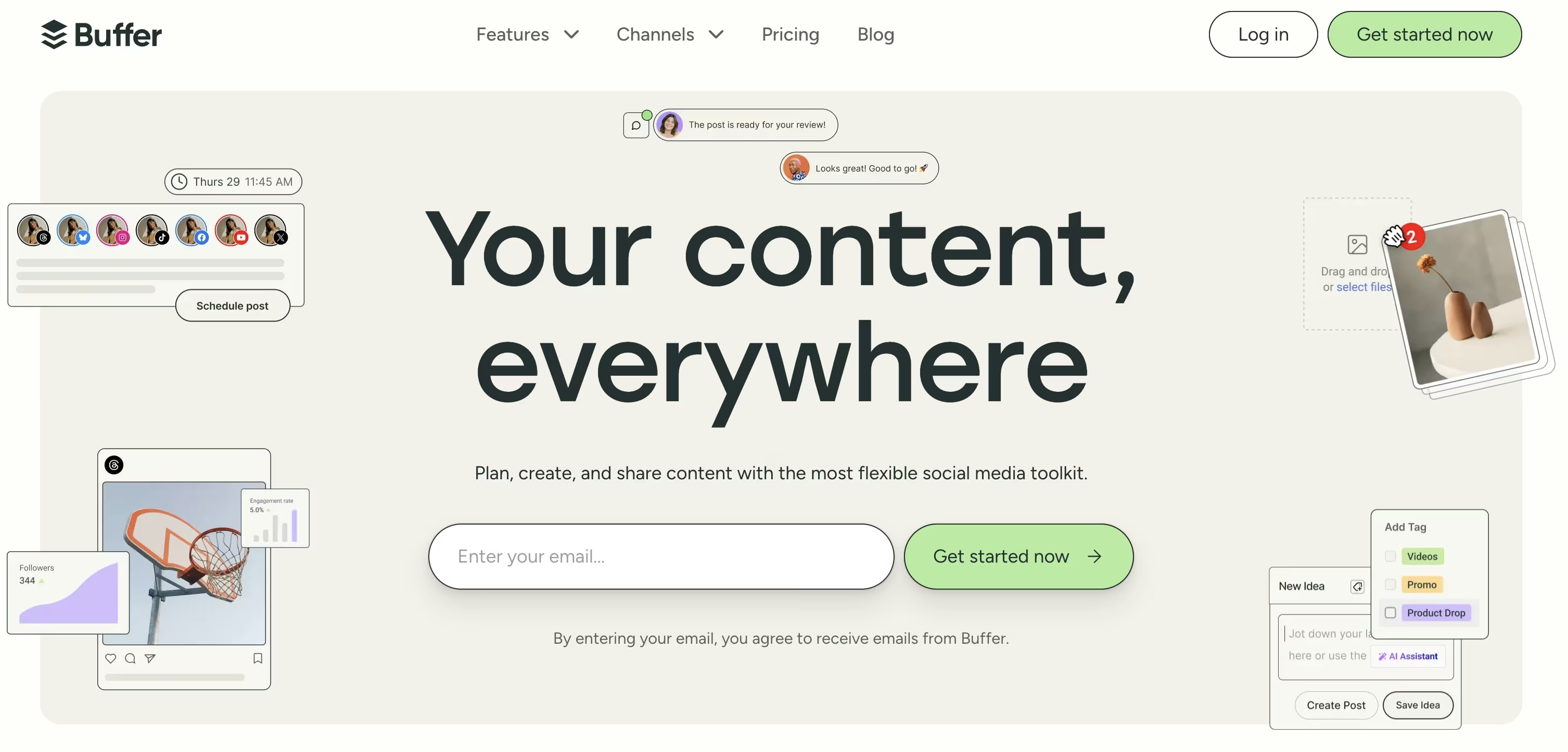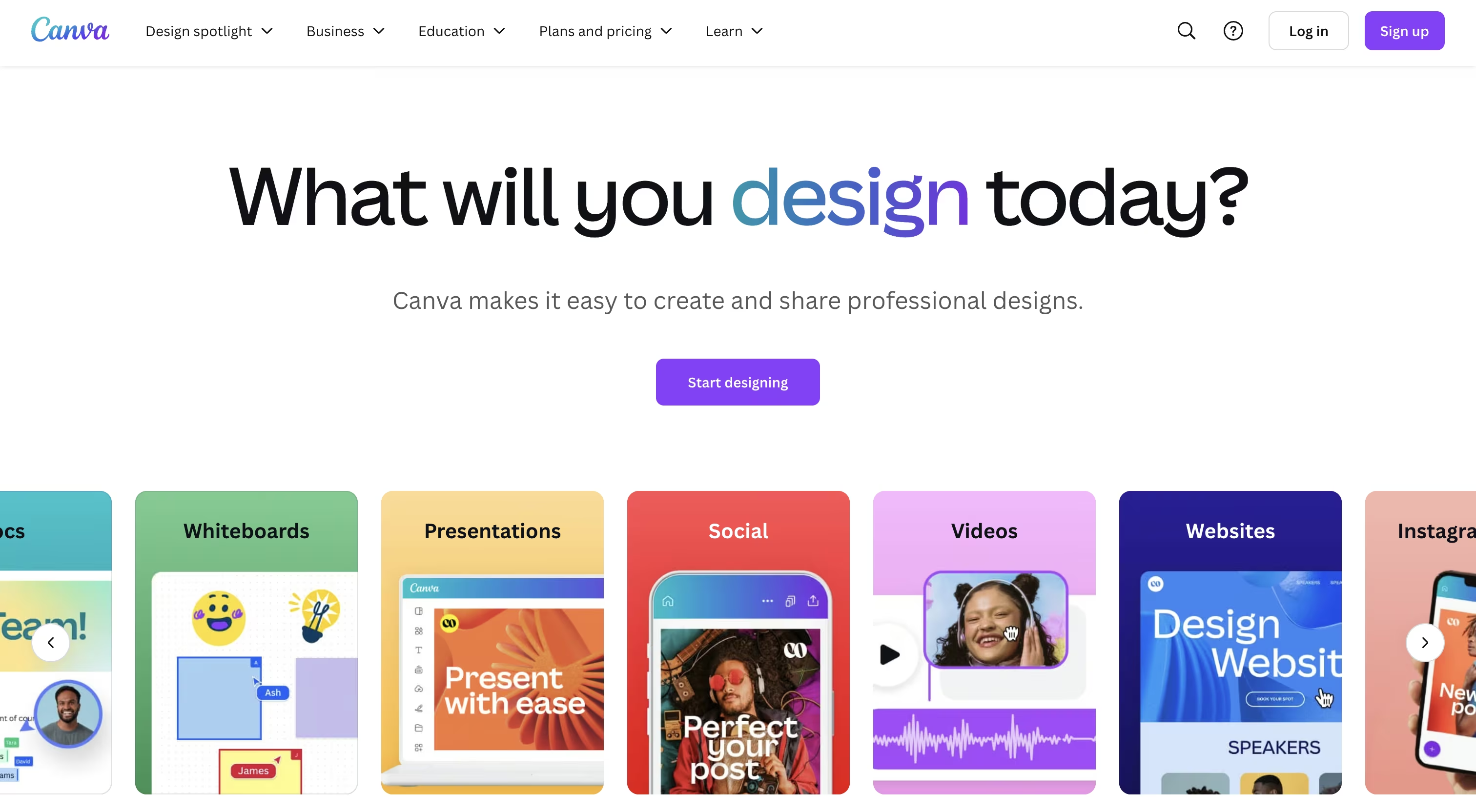
효과적인 소셜 미디어 콘텐츠 전략 구축하기
AI로 몇 초 만에 최고의 콘텐츠 생성
소셜 미디어 콘텐츠 전략 개발은 강력한 디지털 존재감을 구축하려는 기업을 위해 콘텐츠 재활용을 포함한 체계적인 계획과 실행이 필요합니다. 소셜 미디어 콘텐츠 전략 구현을 통해 브랜드는 알고리즘 변화와 진화하는 사용자 기대를 뚫고 청중의 관심을 사로잡고 측정 가능한 비즈니스 결과를 이끌어낼 수 있습니다. 이 과정은 청중 연구부터 콘텐츠 캘린더 작성까지 여러 단계를 포함하여 플랫폼 전반에 걸쳐 일관된 참여를 보장합니다.
How to Create an Effective Social Media Content Strategy?
Creating a successful social media strategy isn't about random posting or following fleeting trends. It requires a methodical approach that aligns with your overall business goals while addressing your audience's needs.
Before diving into the details, here’s a quick overview of the key steps for developing a high-impact social media content strategy:
- Conduct a [content audit: Analyze your current performance, platforms, and content to identify what’s working and what needs improvement.][strong]
- Define Your Social Media Goals and Objectives: Set SMART goals that align with your business objectives and guide your content direction.
- Identify and Research Your Target Audience: Understand who you're speaking to by researching demographics, interests, and platform behaviors.
- Analyze Competitor Content Strategies: Study your competitors’ approaches to spot content gaps, winning formats, and engagement tactics you can adapt.
- Create Your Brand Voice and Messaging Guidelines: Develop consistent messaging and tone that reflects your brand personality across all platforms.
- Choose the Right Social Media Platforms: Focus on the channels where your audience is most active and that align best with your content type.
- Develop a Content Calendar and Posting Schedule: Plan your content themes, formats, and timing to maintain a consistent publishing rhythm.
- Create Engaging Content for Each Platform: Design platform-specific content that delivers value, encourages interaction, and supports your goals.
- Measure, Analyze, and Optimize Your Strategy: Regularly review performance metrics, test new approaches, and refine your strategy for better results.
Conduct a Social Media Audit
Before planning your future strategy, you need to understand where you currently stand. A comprehensive social media audit helps you evaluate your existing presence and identify opportunities for improvement.
During your audit, be sure to:
- Document all your social media accounts, including inactive ones
- Analyze your performance metrics across each platform (engagement rates, follower growth, conversion rates)
- Review your most successful and least successful content
- Identify which platforms are delivering the best results for your efforts
- Assess your posting frequency and consistency
- Examine your audience demographics on each platform
This audit provides valuable baseline data that will inform your strategy development. Look for patterns in your high-performing content and note any gaps or inconsistencies in your current approach.
Define Your Social Media Goals and Objectives

Your social media efforts should support specific business objectives. Without clear goals, you'll struggle to measure success or justify your social media investments.
When setting your social media objectives, make them SMART:
- Specific : Clearly define what you want to accomplish
- Measurable : Include metrics that allow you to track progress
- Achievable : Set realistic goals based on available resources
- Relevant : Align with your broader business objectives
- Time-bound : Establish deadlines for achieving each goal
Common social media objectives include:
- Increasing brand awareness (measured by reach, impressions, followers)
- Driving website traffic (measured by clicks, referrals)
- Generating leads (measured by form submissions, downloads)
- Boosting engagement (measured by likes, comments, shares)
- Providing customer support (measured by response time, resolution rate)
- Increasing sales (measured by conversions and revenue)
Each objective should have corresponding KPIs (Key Performance Indicators) that you'll use to measure progress. This clarity ensures that every piece of content you create serves a strategic purpose.
Identify and Research Your Target Audience
Effective social media content addresses the specific needs, interests, and pain points of your target audience. Generic content aimed at everyone typically resonates with no one.
To define and understand your target audience:
- Create detailed buyer personas for different audience segments
- Collect demographic data (age, location, income, education)
- Gather psychographic information (values, interests, lifestyle, challenges)
- Research which social platforms your audience prefers
- Analyze when your audience is most active online
- Identify the content types that resonate most with your audience
- Study the language and terminology your audience uses
The more you know about your audience, the better you can tailor your content to their preferences. Consider conducting surveys or interviews with existing customers to gain deeper insights into their social media habits and content preferences.
Analyze Competitor Content Strategies

Studying your competitors' social media presence can reveal valuable insights about what works in your industry and help you identify opportunities to differentiate your brand.
When analyzing competitors, look at:
- Which platforms they're using most actively
- Their posting frequency and timing
- Content types that generate the most engagement
- Their messaging and tone of voice
- How they respond to trends and current events
- The hashtags and keywords they use
- Their audience engagement strategies
- Any gaps or weaknesses in their approach
This competitive analysis isn't about copying your competitors but rather learning from their successes and failures to inform your own strategy. Look for underserved content niches or engagement opportunities that your competitors may have overlooked.
Create Your Brand Voice and Messaging Guidelines
Consistency in voice and messaging helps build brand recognition and trust. Your social media content should reflect your brand's personality and values across all platforms.
To develop your brand voice guidelines:
- Define 3-5 key personality traits that describe your brand
- Create a list of do's and don'ts for your brand voice as part of your content strategy
- Develop sample messaging for different scenarios
- Establish guidelines for using humor, emojis, and slang
- Determine how your voice may vary slightly across platforms
- Create a reference document for all team members who create content
Your brand voice might be formal, casual, inspirational, educational, or playful—but it should always be authentic to your company's values and resonate with your target audience.
Choose the Right Social Media Platforms
Not all social media platforms will be equally valuable for your business. Rather than spreading yourself thin across every network, focus your efforts on the platforms where your target audience is most active and engaged.
Consider these factors when selecting platforms:
- Where your target audience spends their time
- Which platforms align with your content type (visual, written, video)
- Your available resources for content creation and management
- The platforms that best support your specific business goals
- Your competitors' presence and performance across platforms
For most businesses, it's better to excel on 2-3 platforms than to have a mediocre presence on six or seven. Each platform has its own content requirements, audience expectations, and algorithm considerations, so choose strategically based on your specific needs and resources.
Develop a Content Calendar and Posting Schedule

A social media content calendar transforms your strategy from concept to actionable plan. It helps maintain consistency and ensures you're creating a balanced mix of content types.
Your content calendar should include:
- Posting dates and times for each platform
- Content themes or topics for each post
- Content formats (image, video, poll, story, etc.)
- Copy drafts or key messaging points
- Visual elements or assets needed
- Relevant hashtags and keywords
- Team member responsibilities
- Approval workflows and deadlines
Your posting frequency should reflect both your audience's expectations and your team's capacity to create quality content. Consistency is more important than volume—it's better to post three high-quality pieces of content weekly than to post mediocre content daily.
Create Engaging Content for Each Platform
Content creation for social media is where your strategy comes to life. Each piece of content should be platform-appropriate, align with your brand voice, and serve your business objectives.
Effective social media content:
- Provides value (educates, entertains, or inspires)
- Is visually appealing and professionally presented
- Includes strong calls-to-action when appropriate
- Is optimized for each platform's specifications
- Encourages engagement and conversation
- Reflect current trends or timely topics when relevant
- Tells your brand story consistently across posts
Remember that content optimization for social media is crucial. Each platform has its own ideal image sizes, video lengths, and text limitations. Taking the time to optimize your content for each platform dramatically improves its performance.
Measure, Analyze, and Optimize Your Strategy
Social media strategy isn't a "set it and forget it" proposition. Regular analysis helps you identify what's working, what isn't, and how to continuously improve your approach.
Establish a regular cadence for reviewing performance metrics:
- Track KPIs aligned with your objectives
- Compare current performance to baseline and previous periods
- Identify your highest and lowest performing content
- Look for patterns in engagement based on content type, posting time, or topics
- Gather audience feedback through comments, messages, or surveys
- Test new approaches based on your findings
Aim to review basic metrics weekly, conduct deeper analysis monthly, and perform comprehensive strategy evaluations quarterly. This ongoing optimization ensures that your social media efforts continue to deliver results as platforms evolve and audience preferences change.
소셜 미디어 콘텐츠 전략을 위한 필수 AI 도구는 무엇인가요?
적절한 도구는 소셜 미디어 콘텐츠 관리를 극적으로 간소화하고 콘텐츠 품질을 향상시킬 수 있습니다. 특히 AI 기반 솔루션은 소셜 미디어 관리자와 콘텐츠 제작자에게 게임 체인저 역할을 하며, 특히 AI 콘텐츠 생성 영역에서 그렇습니다.
Eskritor: 올인원 콘텐츠 제작 솔루션
Eskritor는 소셜 미디어 전략을 변화시킬 수 있는 강력한 AI 콘텐츠 제작 도구로 두각을 나타냅니다. 직관적인 인터페이스와 고급 AI 기능을 갖춘 Eskritor는 몇 시간이 아닌 몇 분 만에 매력적이고 플랫폼별 콘텐츠를 생성하는 데 도움을 줍니다.
Eskritor를 소셜 미디어 콘텐츠 제작에 이상적으로 만드는 주요 기능은 다음과 같습니다:
- AI 기반 콘텐츠 프롬프트: Eskritor는 Instagram, YouTube, 블로그와 같은 소셜 미디어 플랫폼을 위해 특별히 설계된 프롬프트를 제공합니다. 이러한 프롬프트는 각 플랫폼의 고유한 요구 사항과 사용자 기대에 최적화된 콘텐츠를 작성하는 데 도움이 됩니다.
- 다양한 콘텐츠 변형: 유사한 메시지에 대한 새로운 접근 방식이 필요할 때, Eskritor는 다양한 표현과 톤으로 콘텐츠의 여러 버전을 생성하여 선택하거나 캠페인 전반에 걸쳐 테스트할 수 있는 옵션을 제공합니다.
- 콘텐츠 강화: "강화" 명령은 관련 데이터, 인용구, 예시 또는 비유를 자동으로 추가하여 게시물을 더 유익하고 매력적으로 만들어 콘텐츠에 깊이를 더합니다.
- 완전한 문서 편집: 한 번의 클릭으로 모든 콘텐츠에 걸쳐 광범위한 개선을 수행하여 소셜 미디어 캠페인 전반에 걸쳐 일관된 품질과 메시징을 보장합니다.
전략을 보완하는 최고의 계획 및 캘린더 도구
Eskritor가 콘텐츠 제작에 탁월한 반면, 다음과 같은 추가 도구는 소셜 미디어 워크플로우의 다른 측면을 관리하는 데 도움이 될 수 있습니다:

- Hootsuite : 여러 소셜 계정을 관리하기 위한 종합 플랫폼인 Hootsuite를 사용하면 단일 대시보드에서 콘텐츠를 예약하고, 언급을 모니터링하며, 성과를 분석할 수 있습니다.
- 주요 기능: 다중 플랫폼 일정 관리, 팀 협업, 모니터링 스트림, 분석
- 최적 대상: 다양한 플랫폼에서 여러 소셜 계정을 관리하는 기업
- 주요 기능: 다중 플랫폼 일정 관리, 팀 협업, 모니터링 스트림, 분석
- 최적 대상: 다양한 플랫폼에서 여러 소셜 계정을 관리하는 기업

- Buffer : 사용자 친화적인 인터페이스로 알려진 Buffer는 일정 관리 프로세스를 단순화하고 게시 전략을 최적화하는 데 도움이 되는 강력한 분석을 제공합니다.
- 주요 기능: 직관적인 일정 관리, 최적 시간 제안, 참여 지표, 링크 단축
- 최적 대상: 단순함과 효율성을 찾는 중소기업
- 주요 기능: 직관적인 일정 관리, 최적 시간 제안, 참여 지표, 링크 단축
- 최적 대상: 단순함과 효율성을 찾는 중소기업

- Canva : 주로 디자인 도구이지만, Canva의 소셜 미디어 템플릿과 일정 관리 기능은 시각적 콘텐츠를 만들고 계획하는 데 가치가 있습니다.
- 주요 기능: 디자인 템플릿, 브랜드 키트, 콘텐츠 플래너, 직접 게시
- 최적 대상: 전담 디자이너 없이 일관된 시각적 콘텐츠를 만들어야 하는 팀
- 주요 기능: 디자인 템플릿, 브랜드 키트, 콘텐츠 플래너, 직접 게시
- 최적 대상: 전담 디자이너 없이 일관된 시각적 콘텐츠를 만들어야 하는 팀
Eskritor의 강력한 콘텐츠 제작 기능과 이러한 전문 계획 및 일정 관리 도구를 결합하면 모든 채널에서 일관되고 고품질의 콘텐츠를 제공하는 효율적인 소셜 미디어 워크플로우를 구축할 수 있습니다.
결론
효과적인 소셜 미디어 전략을 구축하는 것은 일회성 노력이 아니라 계획, 제작, 측정 및 최적화의 지속적인 과정입니다. 이 가이드에 설명된 9단계를 따르면 비즈니스 목표에 부합하고, 대상 청중과 공감하며, 측정 가능한 결과를 제공하는 프레임워크를 개발할 수 있습니다.
양보다 일관성과 품질이 더 중요하다는 점을 기억하세요. 많은 플랫폼에 리소스를 너무 얇게 분산시키는 것보다 신중하게 선택한 몇 개의 플랫폼에서 탁월한 성과를 내는 것이 좋습니다. 그리고 Eskritor와 같은 AI 기반 도구를 사용하면 품질이나 진정성을 희생하지 않고도 콘텐츠 제작 효율성을 크게 높일 수 있습니다.
오늘부터 이러한 단계를 구현하면 단순히 관심을 끄는 것뿐만 아니라 그 관심을 의미 있는 비즈니스 성과로 전환하는 소셜 미디어 존재감을 구축하는 데 큰 도움이 될 것입니다.
소셜 미디어 콘텐츠를 한 단계 높은 수준으로 끌어올릴 준비가 되셨나요? Eskritor를 사용해보고 AI 기반 콘텐츠 제작이 소셜 미디어 전략을 어떻게 변화시킬 수 있는지 경험해보세요.
자주 묻는 질문
소셜 미디어 콘텐츠 제작을 위한 최고의 AI 도구는 Eskritor입니다. 맞춤형 프롬프트, 톤 조정, 플랫폼별 예시를 활용해 다양한 플랫폼에서 콘텐츠를 계획, 작성, 최적화할 수 있습니다. Eskritor는 콘텐츠를 다양한 형식으로 재활용하여 시간을 절약하면서도 일관성과 참여도를 높여줍니다.
게시 빈도는 플랫폼, 타깃 오디언스, 가용 리소스에 따라 달라집니다. 항상 양보다 질이 중요합니다—매일 평범한 콘텐츠를 올리는 것보다 주 3-4회 고품질 게시물을 공유하는 것이 효과적입니다. 지속 가능한 일정으로 시작해 참여 지표와 오디언스 피드백에 따라 조정하세요.
소셜 미디어 전략은 목표 설정, 타깃 오디언스 선정, 플랫폼 선택 등 소셜 플랫폼에 대한 전반적인 접근 방식을 다룹니다. 콘텐츠 전략은 어떤 콘텐츠를 어떻게 제작할지, 그리고 이것이 마케팅 목표를 어떻게 지원하는지에 초점을 맞춥니다. 두 전략은 소셜 미디어 성공을 위해 상호보완적으로 작용합니다.
성과가 좋은 콘텐츠는 플랫폼마다 다르지만, 일반적으로 시각적 요소를 포함하고 문제를 해결하거나 스토리를 전달하거나 오디언스를 즐겁게 하는 콘텐츠가 효과적입니다. 교육 콘텐츠, 비하인드 스토리, 사용자 생성 콘텐츠, 인터랙티브 게시물(설문조사, 질문)은 대체로 높은 참여율을 이끌어냅니다.
주요 기념일, 제품 출시, 업계 이벤트를 파악하는 것부터 시작하세요. 그다음 목표에 맞는 콘텐츠 테마와 주제를 계획하세요. 스프레드시트나 전용 도구를 활용해 게시 날짜, 콘텐츠 유형, 플랫폼, 카피, 시각 자료를 정리하세요. 원활한 실행을 위해 팀 역할 분담과 승인 프로세스도 포함하세요.





 아랍 에미리트 두바이
아랍 에미리트 두바이